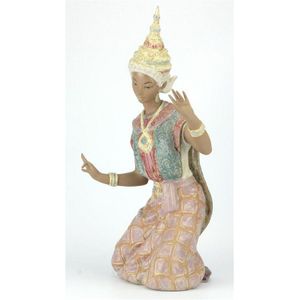Tang Dynasty Earthenware 'Fat Lady' Figure
You must be a subscriber, and be logged in to view price and dealer details.
Subscribe Now to view actual auction price for this item
When you subscribe, you have the option of setting the currency in which to display prices to $Au, $US, $NZ or Stg.
- Earthenware - A basic ceramic material that is fired at a low temperature. Earthenware is the basis of almost all ancient, medieval, Middle Eastern and European painted ceramics. After firing, the colour is the colour of the clay when it is dug from the ground: buff, brown and red. It is not waterproof until glazed. Creamware is a type of earthenware covered with a transparent lead glaze. Majolica, faience and delft are also earthenware covered in an opaque white tin glaze.
This item has been included into following indexes:
Visually similar items

A Chinese earthenware figure of a seated court lady with mirror, Tang Dynasty (618-906 AD), depicted at her toilette, gazing appreciatively at her image in the mirror that se holds up with her left hand, with rouged cheeks, elaborate fan-like chignon and c

A rare pair of Chinese Tang musician figures with, stands, Tang dynasty (618-907). Height 29 cm, note: with TL test: Thermoluminescence laboratory

A large grey pottery court lady, Han Dynasty (206BC- 220AD), with original red white and black pigment her hand folded inside her sleeves, 44 cm high

Lladro figure 'Thai girl kneeling' issue year 1977. Retirement year 2000. Sculptor Vicente Martínez. Condition good to fair, chip & restoration to the hat. Dimensions 42 x 23 cm
